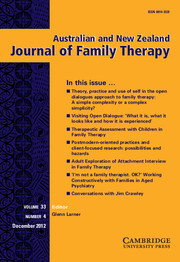Article contents
Adult Exploration of Attachment Interview in Family Therapy
Published online by Cambridge University Press: 28 January 2013
Abstract
The Adult Exploration of Attachment Interview (AEAI) is a therapeutic interview developed by the author to assist adults to understand themselves and their relationships with others, especially with a partner, co-parent and/or children. It is suitable for individuals and couples struggling to overcome repeated patterns of relating, helping to improve their intimate or parenting relationships through greater self and other understanding. The AEAI explores an adult's early relational learning, especially in regard to attachment needs, in order to allow change. The interview uses specific externalising language to help persons tolerate difficult memories, reduce guilt and shame and integrate their thoughts and feelings. It applies key implications of attachment theory and the approach is illustrated by examples from therapy.
- Type
- Articles
- Information
- Australian and New Zealand Journal of Family Therapy , Volume 33 , Issue 4 , December 2012 , pp. 309 - 320
- Copyright
- Copyright © The Authors 2013
References
- 5
- Cited by




